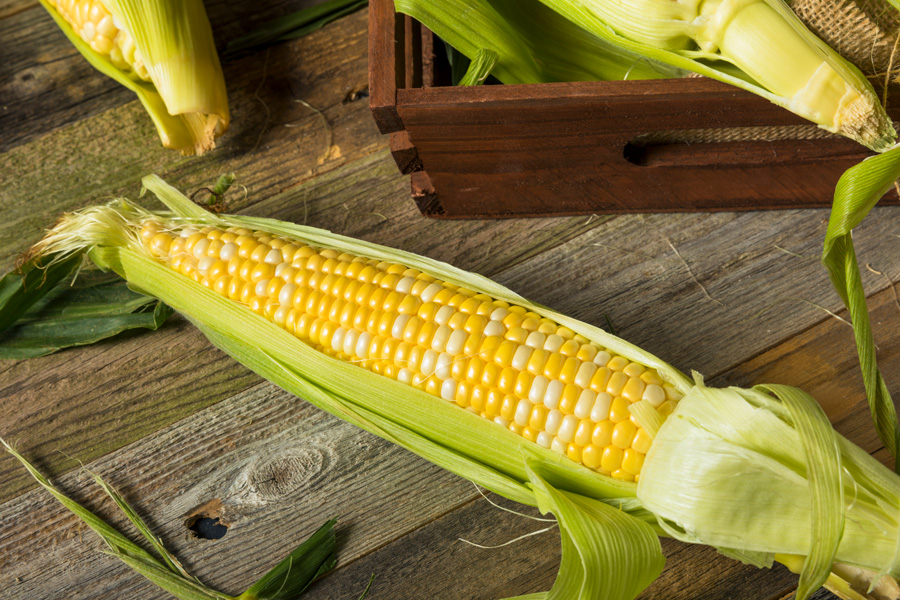
Key takeaways:
- Georgia is the third largest producer of fresh market sweet corn in the United States.
- There are two growing seasons for sweet corn in Georgia; spring yields tend to be higher than fall yields.
- Different varieties and planting densities may be selected for spring and fall to produce optimal yields and ear size and to reduce defects.
- Corn seed quality is paramount; look for > 90% germination with high uniformity and vigor.
- Maturity level is very important for sweet corn harvest, which takes place in a 3-day window.
- U.S. Fancy grade is the most desirable; ears must be greater than 6 in. long with a blank tip less than one-quarter of the ear length.
Contents:
- Industry Overview
- Planting
- Harvesting
- Important Ear Characteristics
- Variety Selection
- Defects
- References
Industry Overview
Sweet corn (Zea mays subsp. mays), grown in southern Georgia, is primarily intended for the wholesale shipping market. Fresh market sweet corn is harvested, boxed, cooled, and shipped to retailers for this market segment. All shipper corn has a supersweet endosperm type derived from the shrunken 2 (sh2) gene, which extends the shelf life of sweet corn by delaying the conversion of sugar to starch (Tracy, 1997). Other sweet corn endosperm types convert sugar to starch more rapidly and need to be isolated from supersweet corn to prevent contamination. Although available from some seed companies, genetically modified organisms (GMO) currently are not used by growers in wholesale shipper sweet corn production because of market demands. Many large retailers and certain countries prohibit GMO fresh market vegetables. In terms of approximate sweet corn acreage planted, bicolor accounts for 70%, yellow accounts for 25%, and white accounts for 5% (see Recommended Varieties below); both customer demands and the logistics of growing the corn account for this. Yellow kernel color is a dominant gene and white is recessive. Bicolor and yellow corn can be planted together in the same field, but white corn needs to be isolated from both bicolor and yellow to avoid contamination.
Recommend Shipper Sweet Corn Varieties for Southern Georgia in 2022
Bicolor corn: Obsession, 7143, BSS1075, BSS8021, 2182, Coastal, Awesome
Yellow corn: Passion, 1336, GSS 1170, Accentuate, Gallant, Alliance
White corn: Glacial, Coronado, XTH 3380
Georgia is the third largest producer of fresh market sweet corn in the United States (NASS, 2012), with over 27,000 acres harvested annually (Stubbs, 2019). Sweet corn is the second most-valuable vegetable crop in Georgia. Most of the commercial shipper sweet corn is produced in the southwestern area of the state, with Decatur and Mitchell counties accounting for 80% of the state’s shipper sweet corn production. This area historically has grown row crops, so growers had the equipment and irrigation infrastructure to easily add sweet corn as a vegetable in their rotation—which also can be more profitable than row crops. Pesticide applications are made with a tractor while the corn is small; once the corn is taller and filled in, pesticide applications typically are made with a crop duster. Aerial applications are critical to cover vast acreage in a short amount of time, as daily applications often are needed to keep the crop free from corn earworms during kernel development.
Georgia has a unique and important harvest slot for sweet corn in the eastern U. S. (Table 1). In the spring, sweet corn harvest starts in Florida during April with a push to finish by Memorial Day. There are two reasons for this. First, there is a large amount of consumption during Memorial Day weekend. Second, Florida’s wet season brings frequent summer rains that cause plant lodging and make fields inaccessible to equipment in the muck soils of the predominant production areas (Figure 1).
| Jan | Feb | Mar | Apr | May | Jun | Jul | Aug | Sep | Oct | Nov | Dec | |
|---|---|---|---|---|---|---|---|---|---|---|---|---|
| Florida | In season | In season | In season | In season | In season | Not in season | Not in season | Not in season | Not in season | Not in season | In season | In season |
| Georgia | Not in season | Not in season | Not in season | Not in season | In season | In season | In season | Not in season | Not in season | In season | In season | Not in season |
| New York & Northern U.S. | Not in season | Not in season | Not in season | Not in season | Not in season | Not in season | In season | In season | In season | Not in season | Not in season | Not in season |
| Note. Green-colored cells labeled "in season" indicate when sweet corn is available within each area. | ||||||||||||
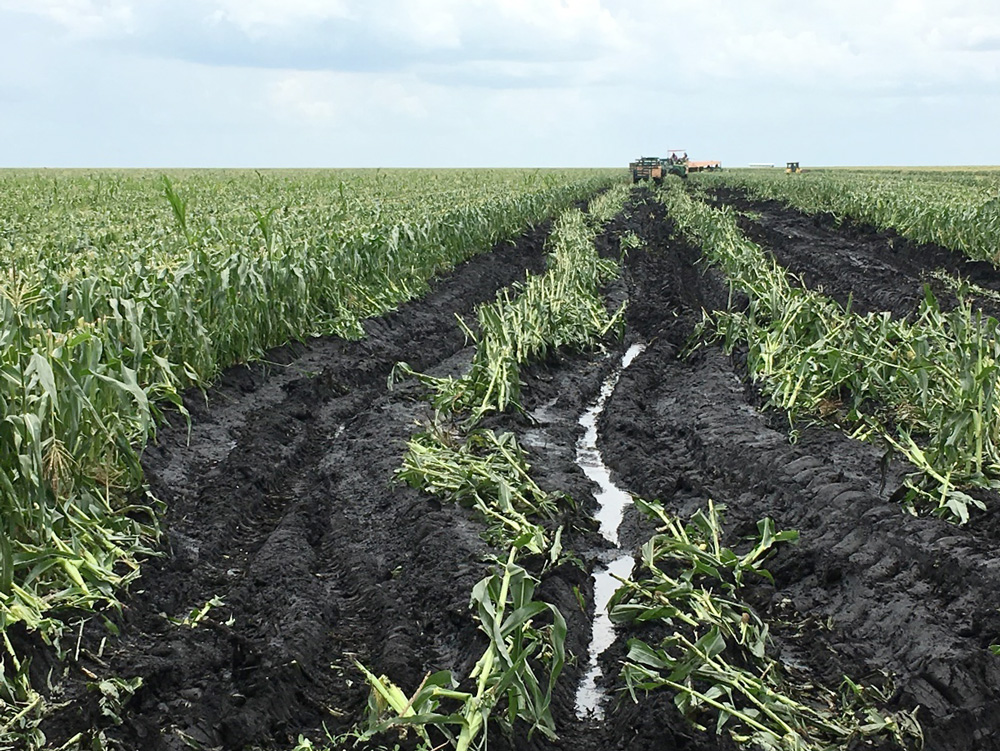
The main spring harvest in Georgia begins in June with a big push to finish before July 4th. Georgia has a competitive advantage once Florida is out of the market. In addition, there is a large amount of sweet corn consumption during the July 4th weekend. Later in the summer, production in Georgia becomes difficult because of high temperatures and frequent rainfall. After Georgia’s production ends, production in New York and other northern states ramps up (ending around the Labor Day weekend). In the fall, production once again shifts back to Georgia, then on to Florida during the late fall and winter. Many large producers have growing and packing operations in multiple states to constantly supply the market.
Planting
Sweet corn in Georgia is largely direct seeded on bare ground utilizing center pivot overhead irrigation. Supersweet corn seed does not have as much vigor as field corn or other types of sweet corn. Therefore, seed quality is paramount in shipper sweet corn production. There is a saying that “every seed should produce a plant and every plant should produce an ear.” Germination percentage from wet paper towel lab studies are specified on the seed bag. However, germination percentage does not account for field emergence, seed uniformity, and vigor. Germination percentages above 90% with high uniformity and vigor are required, especially when planting in the hot soil in late summer for fall production or the cold soils of early spring production (see Recommended Planting Dates in Georgia below). Poor stand establishment, low vigor, and/or subpar uniformity will result in decreased yields.
Recommended Sweet Corn Planting Dates for Southern Georgia
Spring crop planting dates: February 15 through April 15
Fall crop planting dates: July 15 through August 30
In addition to seed quality, increases in seeding uniformity (e.g., using vacuum planters) and decreases in plant loss (e.g., from seed treatments) will increase yields. See Table 2 for seeding rates and spacing in Georgia. Since sweet corn is a once-over harvest seed, uniformity is critical to ensure equal maturity levels at harvest. Late-emerging seed will result in late-maturing sweet corn that will not be ready during harvest. See Table 3 for nitrogen fertilizer recommendations for sweet corn in Georgia.
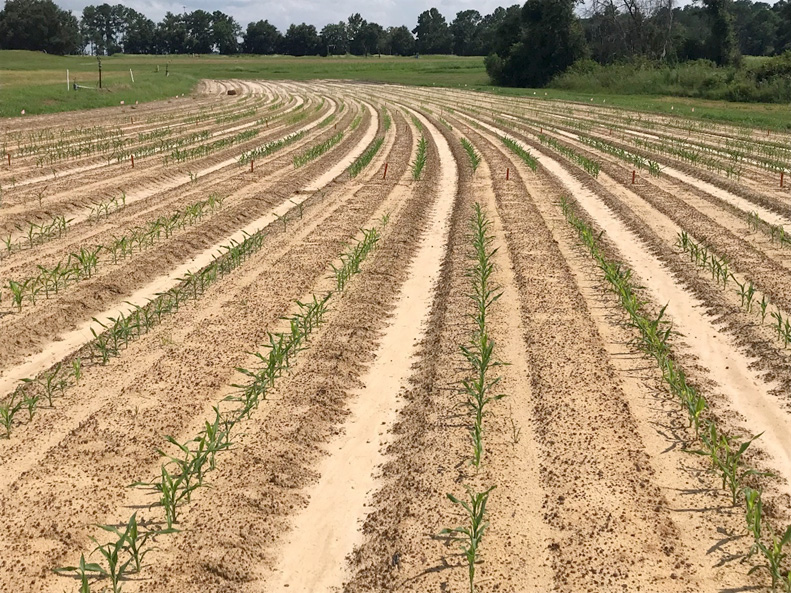
Larger seed typically has better vigor than smaller seed. The seed bag label indicates the number of seeds per pound for that lot. Sweet corn seed is separated into size and shape fractions to increase planting and germination uniformity in the field. The fraction categories are large rounds, large flats, small flats, and small rounds. The larger seed comes from the bottom of the ear, while the smaller seed comes from the top of the ear. The round seed comes from the base and tip of the ear while the flat seed comes from the center of the ear.
Prior to planting, it’s a good idea to conduct a small-field grow out (testing for germination, vigor, and uniformity screening) of available seed lots—both new and carryover—to identify the best seed available (Figure 2).
| Season | Seeding rate | Row spacing | In-row spacing |
|---|---|---|---|
| Spring | 30,000 seed/acre | 30 to 36 in. | 6 to 7 in. |
| Fall | 25,000 seed/acre | 30 to 36 in. | 7 to 8.5 in. |
| Region | Season total nitrogen (N) per acre |
|---|---|
| Coastal Plain | 200 to 250 lb N |
| Northern Piedmont | 150 to 200 lb N |
| Note. Nitrogen (N) rates will vary depending on rainfall, soil type, irrigation, plant population and method and timing of applications. For more efficient use of fertilizer, split the applications—applying one-third to one-half down (banded or incorporated in the bed) and the remainder in one to three applications. Complete fertilizer recommendations for sweet corn can be found online in the University of Georgia Soil Test Handbook: https://aesl.ces.uga.edu/publications/soil/cropsheets/158.pdf. | |
Harvesting
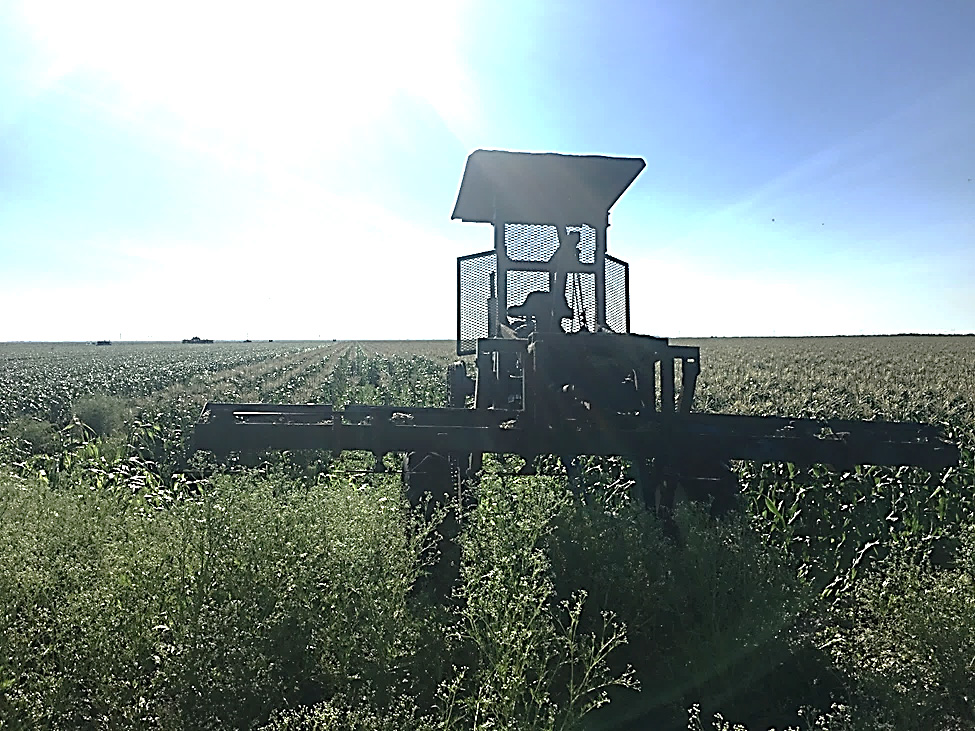
Most commercially produced shipper sweet corn is topped (mowing the stalk above the ear; see Figure 3) and harvested by hand with the aid of a mule train. Topping serves several purposes: (a) it’s a visual indication to the harvest crew which section of a field should be harvested; (b) the decreased plant height means workers do not need to lift harvested corn above their heads; and (c) removing pollen-containing tassels makes it easier for workers to breathe. A mule train is a mobile packing line that allows pickers to throw harvested ears onto a conveyor belt, which then brings the ears to workers that field-pack the corn into wooden crates (Figure 4) or reusable plastic containers (RPCs).
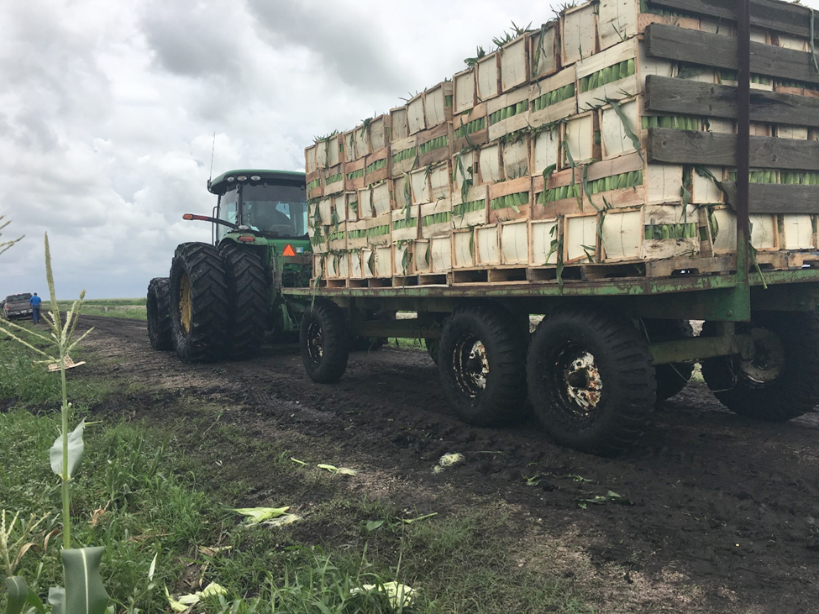
Because of increased labor costs, some growers use mechanical harvesters (Figure 5). However, mechanical harvesting can bruise the ear, especially the ears of more tender varieties. Machine-harvested corn still is graded and boxed in packinghouses. Wooden crates are preferred by shippers as they are cheaper than reusable plastic containers, but both are used to cater to different clients. In addition to selling in boxes, many packinghouses also offer a value-added tray pack (a Styrofoam tray containing four to five shucked ears wrapped in clear plastic). Although the quantity sold is lower in the tray pack, it adds value for the consumer, allows for branding on the containers, and can be an outlet for smaller ears of corn or ears with poor tip fill that can be clipped off.
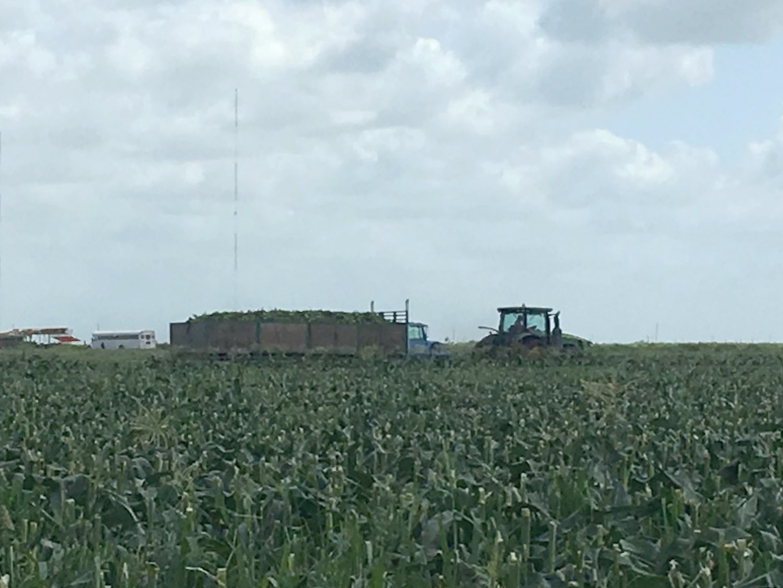
Sweet corn is a once-over harvest, and any slow-maturing ears that are not ready at harvest are abandoned in the field. Growers hope to have one harvestable ear per plant. Historically, increased yields have been achieved with higher plant populations and by utilizing improved genetics under higher-input production. It is possible under ideal conditions for a sweet corn plant to produce two marketable ears per plant that are of similar maturity. However, this cannot be expected by growers. When growers increase plant populations, increases in yield will be diminished once ears become unmarketable because of poor size and/or quality (poor kernel development).
In Georgia, typical yields during the spring season often are in excess of 500 boxes per acre, and during the fall season are around 300–450 boxes per acre. In a perfect scenario with 100% germination and all plants having one marketable ear, a spring yield of 625 boxes per acre (30,000 plants/48 ears per box) is possible; in the fall, a yield of 520 boxes per acre (25,000 plants/48 ears per box) is possible. Higher yields have been reported in years with exceptional growing conditions. Under those conditions, more than one ear per plant may be harvested.
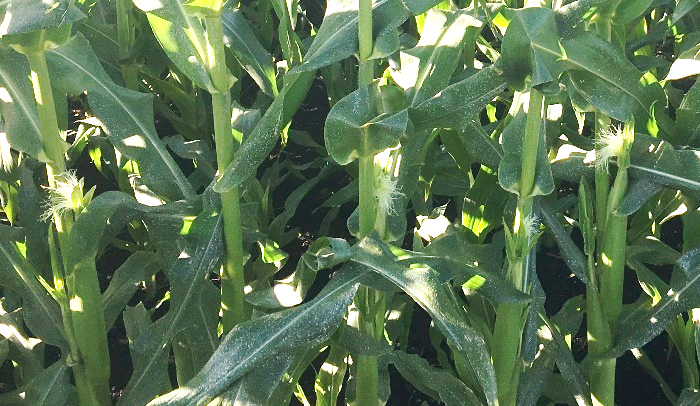
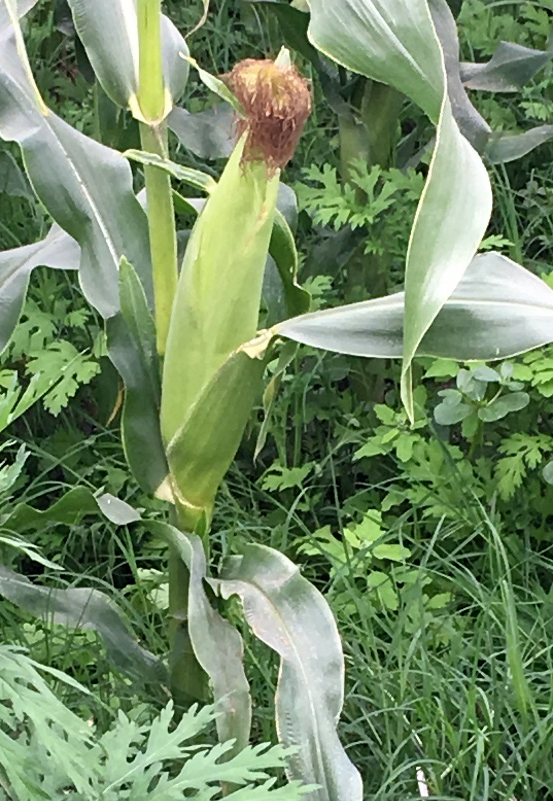
Maturity and moisture level are very important for sweet corn harvest. Sweet corn has to be harvested in an approximately 3-day window (1 day early, prime maturity, or 1 day late). Scheduling corn harvest based on midsilk (when half of the ears have started to produce silk) is common (Figure 6).
Sweet corn varieties that typically are grown in the region take approximately 21 days (± 2 days) from midsilk until fresh harvest. An early indicator that ears are ready to harvest are when silks start to darken (Figure 7).
Harvesting too early will result in smaller size, poor color, and undeveloped sugar content. Harvesting too late will result in big bumpy ears followed by dehydrated, dimpled (dented) kernels (Figures 8a and 8b).
If there’s too much volume of mature corn for the market at the same time, the price typically drops and, in some cases, growers have to leave the corn in the field because they are not able to sell the crop during the short harvest window.
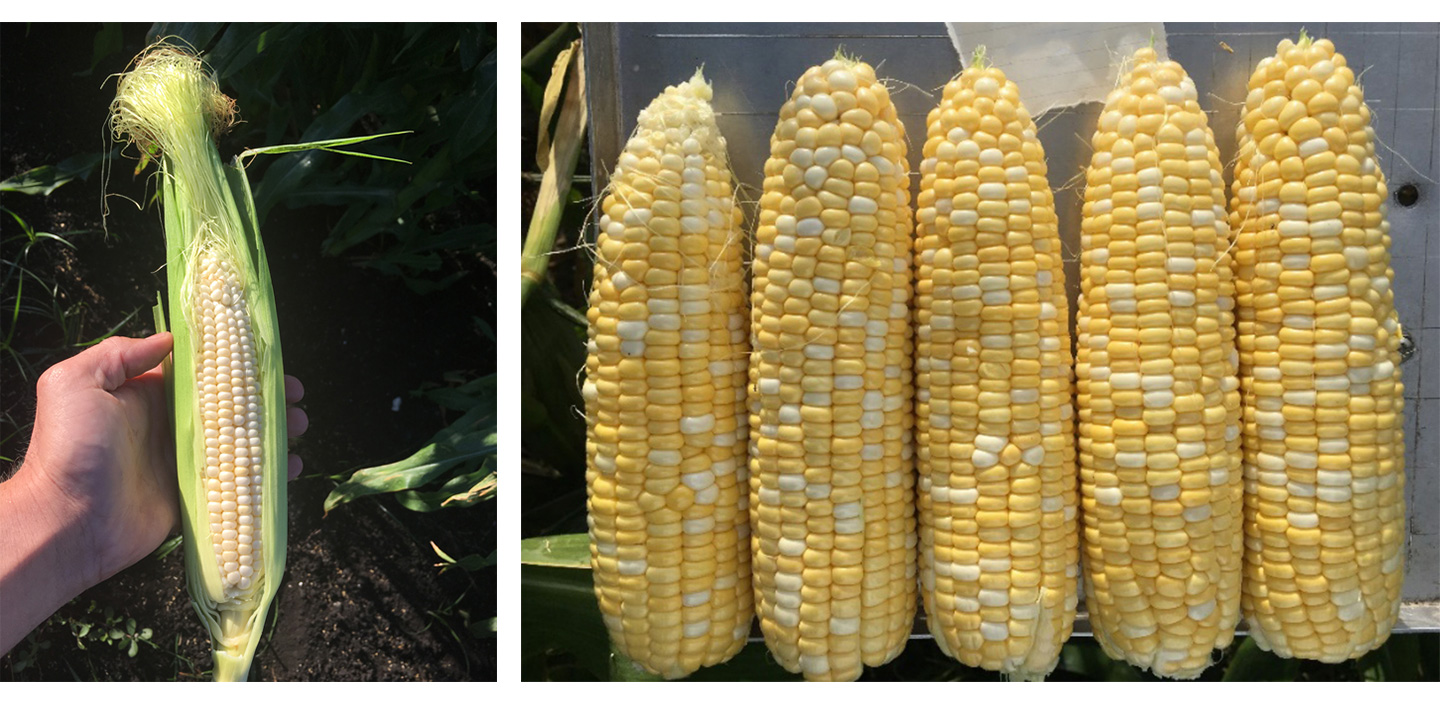
Important Ear Characteristics
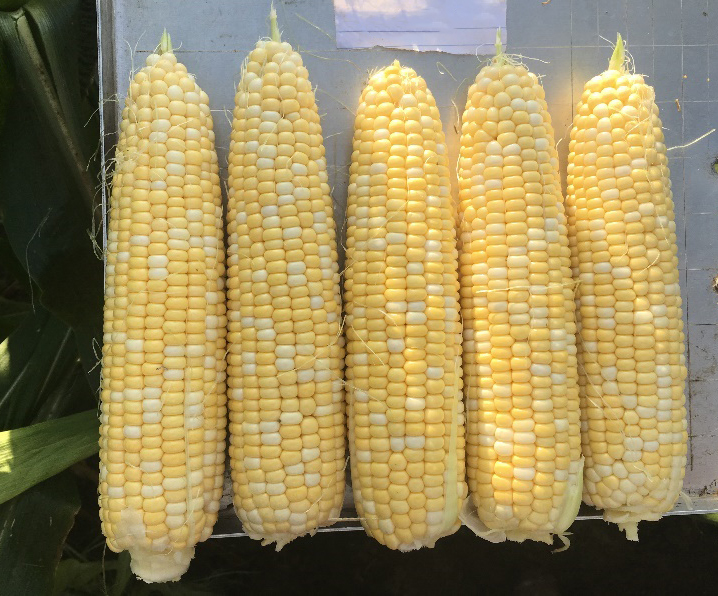
Figure 9a. Ears with good length and width.
The most important ear characteristics of shipper sweet corn are the length, width, tip fill, and shank length. Shipper corn is packed into one of three box sizes:
- 10 by 10 (10 in. tall by 10 in. wide)
- 11 by 11 (11 in. tall by 11 in. wide)
- 12 by 12 (12 in. tall by 12 in. wide)
The 11 by 11 box is preferred by retailers. Shipper corn is sold by count, with 48 ears per box. In order to fit 48 ears into an 11 in. x 11 in. box, the ear size has to be fairly standardized. In a wooden crate 11 in. wide, you can fit six ears across that are 1.8 to 1.85 in. in diameter (11 in. ÷ 6 ears = 1.83 in./ear). The crate also is 11 in. high, so you can fit up to an 8-in. ear with a 3-in. shank (8-in. ear + 3-in. shank = 11 in. total length).
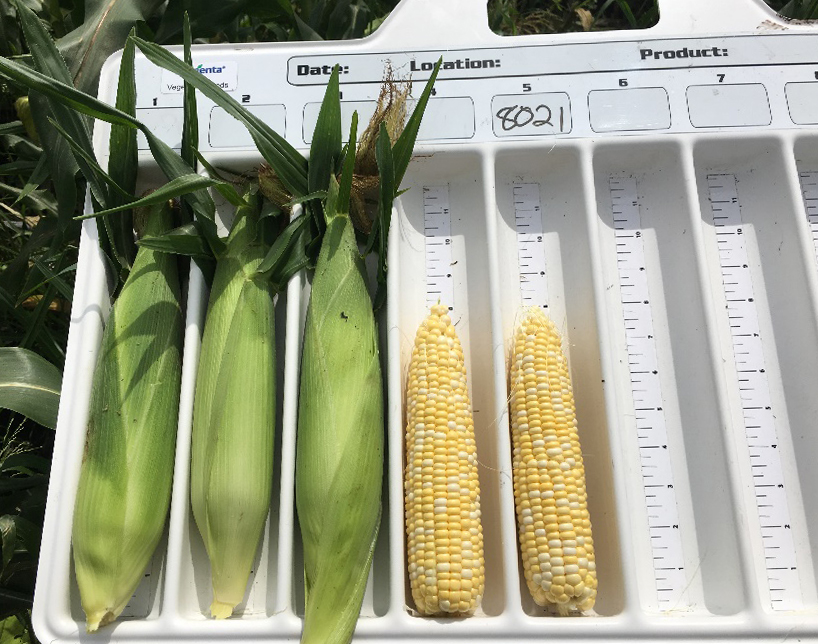
Figure 9b. Ideal sized ears with small shanks, excellent tip fill, large flag leaves and good husk color.
USDA standards for fresh market sweet corn rates sweet corn as U.S. Fancy grade if the ears are greater than 6 in. long and any blank tip is not more than one-quarter of the ear length (1.5-in. blank tip on a 6-in. ear). U.S. Fancy is the most desirable grade of sweet corn and growers receive the most money for this category. However, industry standards typically are more stringent than USDA standards.
Buyers typically desire ears that are at least 7 in. in length with less than 1 in. of blank tip. Under ideal environmental conditions when the market is very competitive, ears should be around 7.5 in. in length (7.3–7.8 in.), 1.85 in. in diameter (1.8–1.9 in.), with less than 0.5 in. of blank tip (0–0.5 in.), and less than 2.5-in. shank length (0–2.5 in.; Figures 9a and 9b).
Variety Selection
Depending on the season, growers in Georgia select varieties with different characteristics. In the fall, ears tend to be smaller (shorter and slimmer), so growing the varieties with a big ear makes more sense. Empirical data suggests that ear size can shrink up to 0.5 in. in length and 0.3 in. in diameter in fall compared to spring.
In the fall growing season, the growing time to maturity is shortened from the typical 77 days to as little as 58 days because of the increased growing-degree-days during July, August, and September. Because of rapid growth and maturity, ears simply do not have enough time to fill out, so shank size is less of a concern in the fall. Preferred varieties demonstrate resistance to southern corn leaf blight, northern corn leaf blight, and rust, especially given the hot and wet weather conditions during late summer and early fall when the plants are growing.
Tip fill is more of an issue in the fall—dry conditions in late fall during ear growth hinder kernel development (Figures 10a and 10b).

Figure 10A. Ears showing good tip fill.
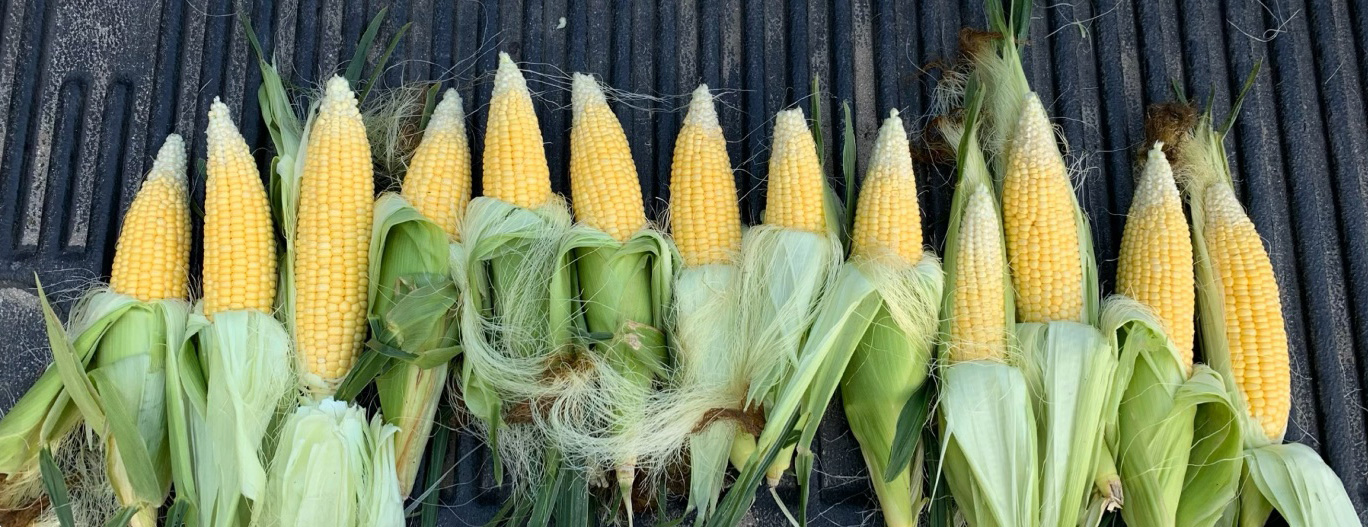
Defects
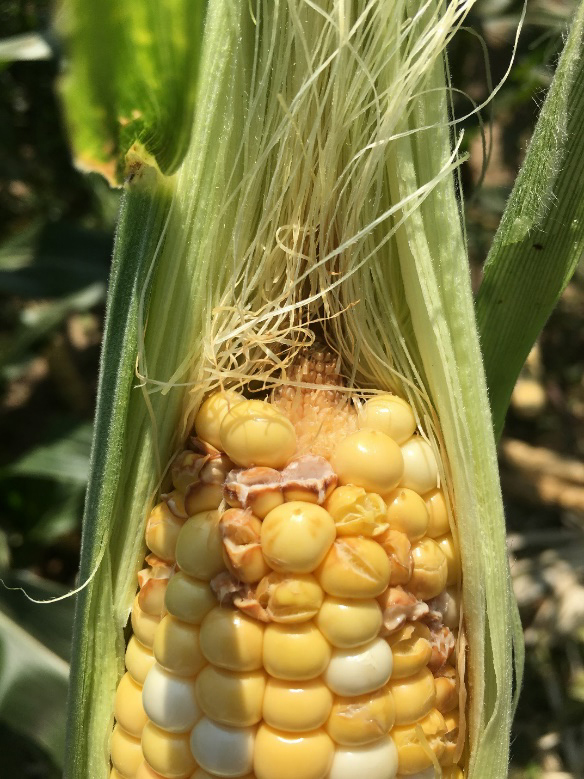
Figure 11. Split kernels leading to secondary infections.
In the spring you want to select for a smaller ear that will hold its size without getting too big; tip fill is easily accomplished but shank size can get too large. Split kernels also are a concern in the late spring (Figure 11).
When temperatures are in the mid-90s and there are frequent rains, kernels can split open—which leads to secondary infections and load rejections. Remember that sweet corn ears are not graded individually before being packed like other vegetable crops. The crop is field-packed and individual boxes are inspected randomly at the packing shed. If the inspected boxes fail over the allowed threshold, then the entire load is rejected.
Insect, disease, nematode, and weed control recommendations can be found in the vegetable section of the Georgia Pest Management Handbook (https://ipm.uga.edu/georgia-pest-management-handbook/).
References
Agricultural Marketing Service. (1992). United States standards for grades of sweet corn. United States Department of Agriculture. https://www.ams.usda.gov/sites/default/files/media/Corn%2C_Sweet_Standard%5B1%5D.pdf
Agricultural Marketing Service. (1994). Sweet corn shipping point and market inspection instructions. United States Department of Agriculture. https://www.ams.usda.gov/sites/default/files/media/Corn%2C_Sweet_%28fresh%29_Inspection_Instructions%5B1%5D.pdf
Agricultural Marketing Service. (n.d.). Sweet corn grades and standards. United States Department of Agriculture. https://www.ams.usda.gov/grades-standards/sweet-corn-grades-and-standards
Kissel, D. E., & Sonon, L. S. (2011). Soil test handbook for Georgia (Special Bulletin 62). University of Georgia Cooperative Extension. https://extension.uga.edu/publications/detail.html?number=SB62
National Agricultural Statistics Service (NASS). (2012). Quick stats [Data set]. United States Department of Agriculture. https://quickstats.nass.usda.gov/results/7F25DA0A-0455-3F22-90E8-FBB390248463
Sial, A., Taylor, M., & Cabrera, E. (Eds.). (2023). Georgia pest management handbook—Commercial edition (Special Bulletin 28). University of Georgia Cooperative Extension. https://extension.uga.edu/publications/detail.cfm?number=SB28
Stubbs, K. (2019). Georgia farm gate value report 2019. University of Georgia Center for Agribusiness and Economic Development. https://caed.uga.edu/content/dam/caes-subsite/caed/publications/annual-reports-farm-gate-value-reports/2019%20Farm%20Gate%20Report.pdf
Tracy, W. F. (1997). History, genetics, and breeding of supersweet (shrunken2) sweet corn. Plant Breeding Reviews, 14, 189–236.
Status and Revision History
Published on May 05, 2023


























































